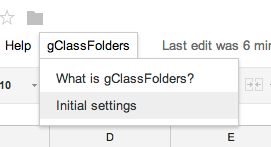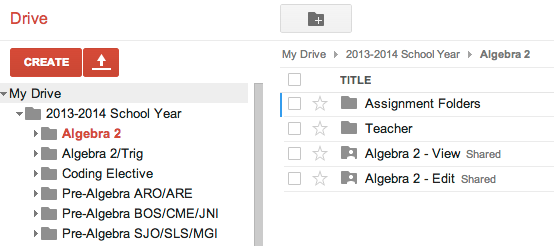Here is a script that will add the contents of a spreadsheet cell to the end of a Google Document that is specified in the Student File Key (here is a spreadsheet where you can Make a Copy):
// The onOpen function is executed automatically every time a Spreadsheet is loaded
function onOpen() {
var ss = SpreadsheetApp.getActiveSpreadsheet();
var menuEntries = [];
// When the user clicks on "writeToDoc Menu" then "Add the Student Note to the end of the Google Document given by the Student File Key", the function writeToDoc is
// executed.
menuEntries.push({name: "Add the Student Note to the end of the Google Document given by the Student File Key", functionName: "writeToDoc"});
menuEntries.push(null); // line separator
// add more entries to the menu by using the method: menuEntries.push({name: "Menu Entry 2", functionName: "function2"});
ss.addMenu("writeToDoc Menu", menuEntries);
}
function writeToDoc() {
//Try to use a named range to pull the problemURL out of each row data. from: https://developers.google.com/apps-script/guides/sheets#reading
var ss = SpreadsheetApp.getActiveSpreadsheet();
var sheet = ss.getSheets()[0];
// Get the range of cells from that sheet.
Logger.log(sheet.getMaxColumns());
var studentInformationRange = sheet.getRange(2,1,sheet.getMaxRows()-1,sheet.getMaxColumns()-1);
// For every row of student data, generate a student object.
var studentObjects = getRowsData(sheet, studentInformationRange);
for (var i = 0; i < studentObjects.length; ++i)
{
var currentStudentObject = studentObjects[i] //get the ith row of data from the studentObjects array
//This fetches a document by ID (found in the URL) and opens it up.
var docID = currentStudentObject.studentFileKey;
if (docID!=="") //if the Student File Key exists then use it otherwise, continue on to the next student
{
var doc = DocumentApp.openById(docID); //open the document specified by the Student File Key column entry
//You could also use var doc = DocumentApp.create(name) to create a new document instead of opening an existing one.
//find the end of the body of the document
var body = doc.getActiveSection();
//get the note for the student from the spreadsheet
var studentNote = currentStudentObject.studentNote;
//put the image into the body of the document found above. Got information from here: https://code.google.com/p/google-apps-script-issues/issues/detail?id=2459
var seatProblem = body.appendParagraph(studentNote);
};
continue; //this makes the else part of my if loop continue on to the next student, used when the Student File Key is blank
}
}
// The onOpen function is executed automatically every time a Spreadsheet is loaded
function onOpen() {
var ss = SpreadsheetApp.getActiveSpreadsheet();
var menuEntries = [];
// When the user clicks on "writeToDoc Menu" then "Add the Student Note to the end of the Google Document given by the Student File Key", the function writeToDoc is
// executed.
menuEntries.push({name: "Add the Student Note to the end of the Google Document given by the Student File Key", functionName: "writeToDoc"});
menuEntries.push(null); // line separator
// add more entries to the menu by using the method: menuEntries.push({name: "Menu Entry 2", functionName: "function2"});
ss.addMenu("writeToDoc Menu", menuEntries);
}
function writeToDoc() {
//Try to use a named range to pull the problemURL out of each row data. from: https://developers.google.com/apps-script/guides/sheets#reading
var ss = SpreadsheetApp.getActiveSpreadsheet();
var sheet = ss.getSheets()[0];
// Get the range of cells from that sheet.
Logger.log(sheet.getMaxColumns());
var studentInformationRange = sheet.getRange(2,1,sheet.getMaxRows()-1,sheet.getMaxColumns()-1);
// For every row of student data, generate a student object.
var studentObjects = getRowsData(sheet, studentInformationRange);
for (var i = 0; i < studentObjects.length; ++i)
{
var currentStudentObject = studentObjects[i] //get the ith row of data from the studentObjects array
//This fetches a document by ID (found in the URL) and opens it up.
var docID = currentStudentObject.studentFileKey;
if (docID!=="") //if the Student File Key exists then use it otherwise, continue on to the next student
{
var doc = DocumentApp.openById(docID); //open the document specified by the Student File Key column entry
//You could also use var doc = DocumentApp.create(name) to create a new document instead of opening an existing one.
//find the end of the body of the document
var body = doc.getActiveSection();
//get the note for the student from the spreadsheet
var studentNote = currentStudentObject.studentNote;
//put the image into the body of the document found above. Got information from here: https://code.google.com/p/google-apps-script-issues/issues/detail?id=2459
var seatProblem = body.appendParagraph(studentNote);
};
continue; //this makes the else part of my if loop continue on to the next student, used when the Student File Key is blank
}
}






















